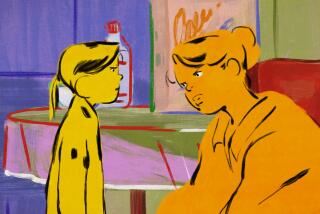They’re pets, not lunch
- Share via
Cherylynn Costner is walking down the Venice boardwalk with Pecker, a brown and red Bantam. He is on a leash in a color that coordinates with Costner’s outfit. “There’s nothing like a chicken -- they’re sweet, they’re lovable,” she says as heads turn along the beachfront and refrains of “Is that a chicken?” can be heard over the din of music and skateboards.
Even in the epicenter of the unusual, a rooster on a leash, contentedly taking in the sea air, attracts attention.
Pecker is a “companion chicken,” the kind of chicken that comes to dinner as a guest, not as the main course. And though chickens are still far more common in the latter role than the former, a number of city dwellers have found them to be affectionate, loyal and entertaining pets. Among those who’ve been charmed is Martha Stewart, whose favorite chickens are the Araucanas (she used the color palette of their eggs -- pastels in blue, green, yellow and pink -- as inspiration for her Sherwin Williams paint line). George B.E. West, a professor of veterinary medicine at UC Davis, goes so far as to predict chickens will become “the pet of the 21st century.”
Costner, an actress who makes her home in Beverly Hills, takes her chickens everywhere with her, from the bank (in her arms wrapped in a baby’s blanket so as not to attract attention) to the Hare Krishna temple for a service, and out to restaurants. Taking a chicken out on the town is not unlike taking a dog out. It must be kept on a leash because it can get a notion to take off -- actually, to fly off. How high? Costner points to a balcony 10 feet up on a beachfront home, “in a heartbeat,” she says and then smiles as three pedestrians stop to take pictures and Pecker “coos” for them.
Chickens enter the friend-of-person world in a variety of ways. Carl Hunter got his chicken at the poultry market on Broadway in L.A.’s Chinatown. He bought Carol (named for her look-alike, Carol Channing) for $7. She is a Silkie, a breed named for long feathers that resemble Persian cat fur. When Hunter got Carol, she was lethargic and dirty, but he knew she was a diamond in the rough. He took her straight to a vet, and a round of antibiotics later, she sits like a white powder puff, fluffed and purring as he pets her.
Hunter and his partner, Dan Hooper, keep several egg-laying and companion chickens at their Silver Lake home. They love the fresh eggs -- especially the pastel ones from the Araucanas. Hunter recently brought some unhatched eggs to work after the hens had left them to care for chicks that already had hatched. He brought heating pads from home to the office kitchen to keep the eggs warm. Word spread throughout his downtown office at the Transamerica Life Insurance Co. and his co-workers became a human foster flock for the young chicks. When two of the chicks hatched Sept. 11 his co-workers promptly named them Patriot and Freedom.
Michelle Duncan is a kindergarten teacher who lives in Torrance. Her class had a chick-hatching project to study the process of life. Even though Duncan took care with the gestating eggs, including staying overnight in her classroom, most of the chicks died. Duncan (who now advocates using butterflies rather than eggs for such projects) felt responsible for the two chicks that survived the classroom project and took them home but came up against a zoning rule prohibiting farm-type animals.
Duncan, 34, hired an attorney and succeeded in persuading the Torrance Environmental Quality Commission (which oversees animal permits and Animal Control) that her roosters, Bunny and Zorro, were companion animals. She even brought in photos of the birds with her family. “The commission was nice about it,” she said. “They said they seem like really nice birds.” But the commission worried that the crowing might disturb neighbors, and required Duncan to get written approval from 20 neighbors.
Bunny and Zorro are full-grown roosters now, each weighing around 14 pounds and more than knee-high to an average human. Duncan and her husband spend a lot of time watching and playing with the birds, whose silly behavior is so entertaining they call it “Chicken TV.”
It’s the kind of relationship that Costner understands. Lately people have been telling Costner that she’s starting to look like her chickens, “but I don’t know which chickens they’re talking about,” she says, and offers an alternative explanation: “Maybe it’s that my chickens are starting to look like me.”






